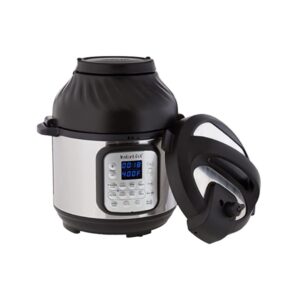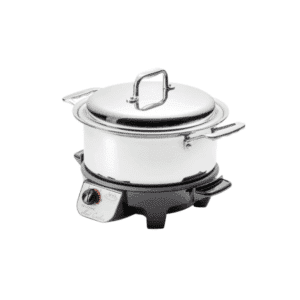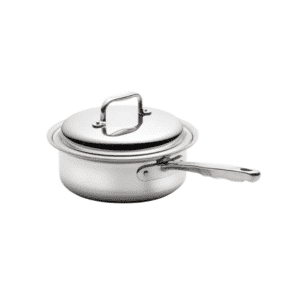Microwaves: those convenient kitchen gadgets that turn ice-cold leftovers into piping-hot delights at the push of a button. But could these time-saving machines be secretly plotting against us? It’s time to uncover the truth about whether microwaves are truly our culinary allies or foes. Join me as we dive into the world of science, radiation, and that age-old question: Are microwaves bad for you? Are there better alternatives? Should you really “nuke” your food?
Keep reading to learn more about microwave safety.

Note: This article contains affiliate links, meaning In On Around will make a small commission at no additional cost to you. This helps me maintain the site. As always, I value full transparency & only work with brands I love and trust.
How Microwaves Work
Microwave ovens are nifty kitchen appliances that quickly heat up food. They use a special kind of energy called “microwaves,” which are like invisible rays of light. Inside the microwave, there’s a part called a “magnetron” that creates these microwaves.
When you put your food in the microwave and start it, these microwaves bounce around. Your food has tiny water molecules inside it, and when the microwaves hit them, they start wiggling around really fast. All this wiggling creates heat, making your food warm. Friction is cooking the food.
It’s a bit like how rubbing your hands together makes them feel warm. Unlike stovetops or ovens that warm food from the outside, microwaves make the inside of your food warm up first. So, the part you bite into might be hotter than the outside.
I talk more about the different wavelengths of light in my article on Red Light Therapy.
The microwave was accidentally invented in 1945 by Percy Spencer, who was leading a project on radar. [1]
Microwave Radiation Levels
Sure, microwaves are ultra-convenient… but don’t they emit radiation? Well, yes, but let’s talk about it:
Microwave radiation might sound a bit intimidating, but it’s not the same kind of radiation you hear about in movies. The radiation from microwaves non-ionizing radiation, which is much milder compared to the harmful ionizing radiation from things like X-rays and nuclear sources.
Microwaves emit low-energy waves that are specially designed to heat food. These waves are not strong enough to break apart atoms or molecules, so they don’t cause damage to our cells. That’s why using a microwave to warm up your leftovers is “generally” considered safe.
In reality, you should be more concerned about the radiation released from your cell phone, instead of the occasional use of a microwave.
Ionizing Vs. Non-Ionizing Radiation – Quick Guide:
Ionizing radiation and non-ionizing radiation are two different things.
- Ionizing radiation:
- Has enough energy to remove electrons from atoms, creating ions and potentially damaging DNA.
- It includes sources like X-rays and gamma rays, commonly used in medical imaging and nuclear processes.
- Non-ionizing radiation:
- Has lower energy and lacks the ability to ionize atoms.
- This includes radio waves, microwaves, visible light, and some forms of ultraviolet radiation.
- While non-ionizing radiation is generally considered less harmful, prolonged exposure to certain types, like intense UV or microwave radiation, can still lead to health risks, such as skin damage or tissue heating.

Microwave Regulations
Regulatory bodies, like the Food and Drug Administration (FDA) in the United States, set limits on the levels of microwave radiation emitted by electronic devices such as microwaves, cell phones, and Wi-Fi routers. A microwave can’t leak more than 5 mW of microwave radiation per square cm at approximately 2 inches throughout its lifetime. [2] Manufacturers are required to conduct testing to ensure their products meet these standards before they can be sold (however, the FDA doesn’t confirm this data via field tests to the manufacturing centers).
The radiation exposure also dissipates very quickly as you move away from the source, so it’s always a good practice to stand away from the microwave if it’s in use. For instance, standing 20 inches from an oven is above 1/100th of the radiation amount compared to 2 inches away. As long as you’re a about 3+ feet away from the microwave, it’s unlikely that there will be any substantial exposure. You can test your EMF exposure using an EMF meter, like with this one.
Nutrient Loss In Microwaved Food
Some people claim that microwaves suck out all the nutrients in food. This claim is really misleading. Let’s explain why:
Yes, microwaves do change proteins and nutrients, BUT this is no different than what happens when you cook on a stove. [3, 4] The more you cook food, the more nutrient loss – this goes for ANY cooking method, not just microwaving. Some people claim that microwaves denature protein, and they’re not wrong. But ALL cooking method denatures protein… it’s not specific to microwaves.
To best preserve nutrients, use shorter cooking times and cooking methods that use as little water as possible. In this case, microwaves fit the bill.
Are Microwaves Linked To Cancer?
No, when used correctly, microwaves are not linked to cancer. [5] The bigger carcinogen concern is the plastic you’re putting your food on in the microwave. Whether they’re marketed to be “microwave safe” or not, it’s best to avoid plastic in general.
Don’t be standing in front of the microwave looking inside as it’s running. Our eyes are particularly sensitive to microwaves, so exposure can cause cataracts at very high levels. [6]
It’s important to avoid using super old microwaves with damaged or warped doors, since they can leak radiation. [7] If the microwave light or turntable stays on after the door is closed, don’t use it. If the microwave works with the door open, dispose of it. The door must be working properly.
Should You Avoid Non-Ionizing Radiation?
Yes, you should aim to avoid certain forms of unnecessary radiation, especially since we’re exposed to so many sources (like cell phones, Wi-Fi, etc…). While microwaves use non-ionizing radiation, it’s still important to reduce your exposure. Make sure you step away from the microwave when it’s in use and make sure the door is completely closed. Press the “off” button before opening the microwave door.
One recent 2023 rat study showed that microwaved water induced stress and epigenetic effects, while another study showed that high levels of non-ionizing radiation can be linked to detrimental changes in the brain. [8, 9]
The radiation from cell phones and Wi-Fi are a much larger concern, in my book, than the occasional use of a microwave.
Formation Of Harmful Compounds
Some people claim that microwaves create harmful compounds in our food. Let’s explain:
Acrylamide is a neurotoxic and carcinogenic substance that can form in food during cooking. Microwave heating at a high power level can lead to acrylamide formation. [10, 11] Acrylamides in general can form when sugars and starches are heated at high temperatures with any form of cooking. Typically, they’re formed during frying, roasting, and baking. Other studies, on the other hand, show that microwaving produces less acrylamides. [12]
All-in-all, research is split on acrylamide formation, but it’s clear that food should not be overcooked. [13]
In addition, some research shows that cholesterol is oxidized at a higher level in both microwave and oven grilling, when compared to pan roasting and pan re-heating. [14] It’s best to avoid microwaving processed meats. Learn more about high-quality meat here: What Is The Healthiest Lunch Meat? Processed Meat 101
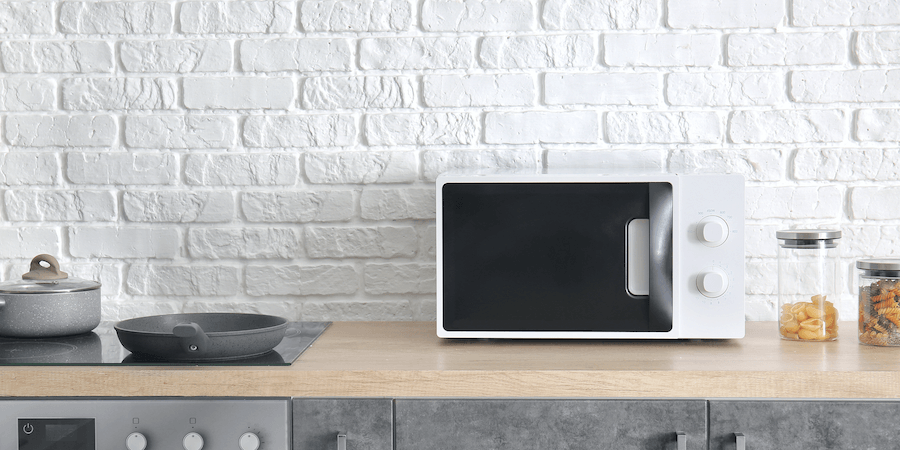
What About Radiolytic Compounds?
A lot of anti-microwave articles reference Dr. Joseph Mercola, who makes unsubstantiated claims. [15] They’re saying that microwaves create radiolytic compounds, which are chemicals made through radiolysis. Radiolytic compounds are made from ionizing irradiation, not non-ionizing radiation, like microwaves. [16] This myth online is completely misleading.
Microwaving does not create radiolytic compounds, despite what many websites claim. Microwaves use non-ionizing radiation. It does not make food radioactive or contaminated.
Many “anti-microwave” myths online resort back to Dr. Mercola’s article on microwaves, which has now been archived. [17] In my opinion, the claims are unsubstantiated.
Debunked: Microwave Blood Transfusion
So, what about that time when someone was given a blood transfusion using microwaved blood and passed away?
Unfortunately, a woman passed away in 1991 because she was given microwaved blood for her transfusion. Blood is typically warmed up for transfusions. However, this unfortunate scenario has a simple explanation: the blood was COOKED, not just warmed, and should not have been used. Overheating blood with any cooking method would produce the same result.
Check Out The In On Around Shop
Microwave-Safe Containers
One of the biggest issues associated with microwaves is the microwave container. A lot of microwave meals are housed in plastic containers that contain Bisphenol A (BPA) and phthalates. BPA-free plastic is NOT necessarily a better option since plastic manufacturers can use other bisphenols (like BPS, BPF) in its place.
Using plastic to cook your food is not safe. Period.
Instead of ditching the microwave altogether, ditch the plastic microwave containers & ultra-processed meals.
Microwave Safety Tips
- Most importantly: ditch the plastic microwave containers
- Microwave-ready meals are typically ultra-processed foods, full of sugar, fat, additives, flavorings, and preservatives. This is a bigger concern!
- If you get healthier microwave meals (like Amy’s Kitchen), I like to put the food on a glass or ceramic plate and cover it with a paper towel.
- To learn more about eating healthy, check out: How To Eat An Anti-Inflammatory Diet
- Leave some space between you and the microwave when it’s running (don’t put your face up to the glass!)
- I prefer to stay about 6 feet away from the microwave
- Be careful not to burn yourself when using a microwave
- Avoid slamming or damaging the microwave door or door hinges
- Make sure the food is cooked thoroughly, otherwise you may be at additional risk for food poisoning
- Microwaves don’t always cook food thoroughly or homogeneously, so make sure it’s heated to at least 140 degrees Fahrenheit to kill pathogens.
- Avoid cooking “sealed” foods like raw eggs or potatoes.
- Since there’s so much water in eggs, the eggs can explode when removing them from the microwave, since the steam is trapped. If you’re microwaving potatoes, always pierce the skin a few times first.
If you’re not comfortable using a microwave, there are many other options for heating food.
Alternatives To Microwaves
If you’re not comfortable using a microwave, there are many other options for heating food, such as:
- Slow cooker
- You can opt for stainelss steel slow cookers, like the InstantPot or 360 Cookware Slowcooker!
- Air Fryer
- To learn more about the best non-toxic air fryers, check out: Safest Non-Toxic Air Fryers Free Of Teflon
- Toasters
- To learn more about the best non-toxic toasters, check out: The Ultimate Guide To Non-Toxic Toasters & Toaster Ovens
- Pan heating
- To learn more about my the best non-toxic cookware brands, check out: Ceramic vs Stainless Steel Cookware – Non-Toxic Guide
If you’d still like to use microwaves, you can re-heat food on glass or ceramic dishes instead of any plastic containers. To learn more about non-toxic dishes, check out: The Ultimate Guide To The Best Non-Toxic Dinnerware
Use whatever cooking method makes you the most comfortable. Instead of freaking out over the occasional microwave use, focus on consuming high-quality foods rich in vitamins and nutrients, like organic fruits and vegetables.
Final Thoughts – Are Microwaves Bad For You?
So many people online say that microwaves should be avoided, but, frankly, I haven’t been convinced by the available research that this is true. Of course, to each their own – if you prefer avoiding a microwave, there are certainly many other cooking methods that can easily replace it.
Here’s my take: I only use a microwave occasionally, like if I’m in a big rush and it’s a matter of whether I eat lunch or not. I usually try to meal prep to avoid these situations, but life happens. When I use a microwave, I keep my distance from it, opt for REAL whole foods instead of processed garbage, and I use glass containers (no plastic).
Listen, I’m all for living as naturally as possible, but I haven’t come across convincing evidence to throw out my microwave. Do I reduce usage as much as I can? Sure, but I won’t be tossing it out anytime soon unless new evidence changes my mind.
If you’re looking for a laugh, here’s a Comedy Central video (parody, of course)!
⬇ Pin this “Are Microwaves Bad For You?” pic on Pinterest for future reference! ⬇
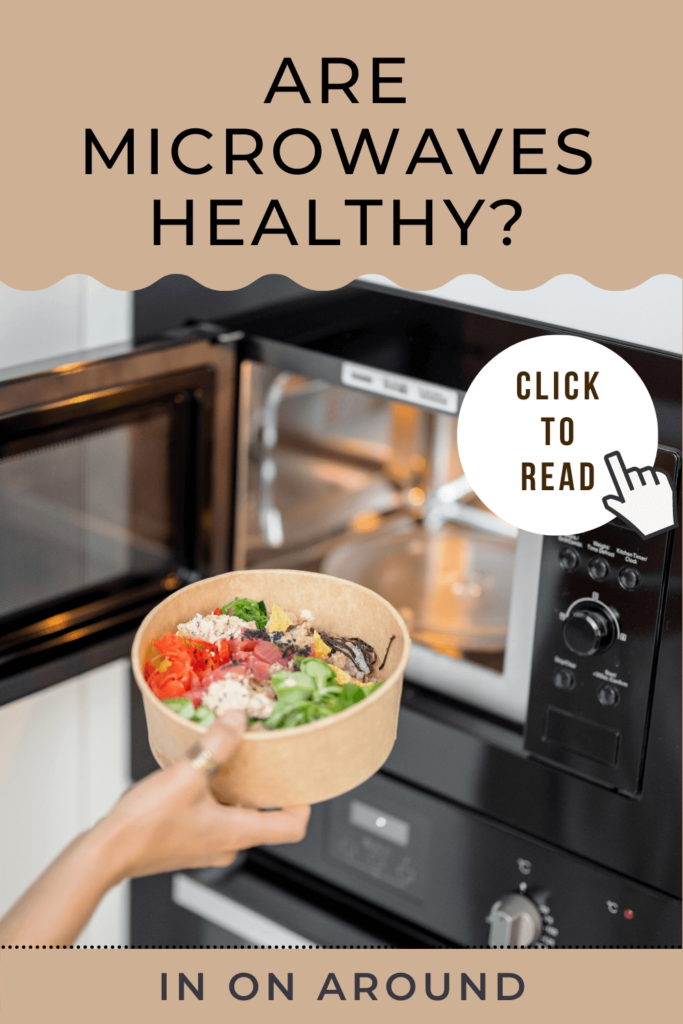
Frequently Asked Questions – Are Microwaves Bad For You?
Click on the below FAQs to learn more about microwave safety, microwave health implications, microwave radiation, microwave oven design, and regulatory standards.
Do microwaves give off radiation?
Is plastic safe to use in microwaves?
What's the best alternative to microwaving?
Are microwave foods healthy?
Do you use a microwave?
Let me know your thoughts and key takeaways in the comments below!
You can watch our web story here.
xoxo,

Want to read more? Check out my other articles here!
Other references on Are Microwaves Bad For You?: Celcook, Good RX, Daniel Plan, BBC Earth Lab, SciShow, WHO, Dr. Klaper, Harvard, FDA, Chris Kresser, Wellness Mama, Food Unfolded, Very Well Health, BBC, McGill, Tech Wellness, Healthline, BistroMD, Legion, Homes & Gardens
Copyright In On Around LLC 2023 ©. The statements made on this website have not been evaluated by the FDA (U.S. Food & Drug Administration). They are not intended to diagnose, treat, cure, or prevent any disease. The information provided by this website should not be used as individual medical advice and you should always consult your doctor for individual recommendations and treatment. The information contained in this site is provided on an “as is” basis. Related to this site, there are no guarantees of completeness, accuracy, usefulness, or timeliness. In On Around LLC assumes no responsibility or liability for any errors or omissions in the content of this site.


